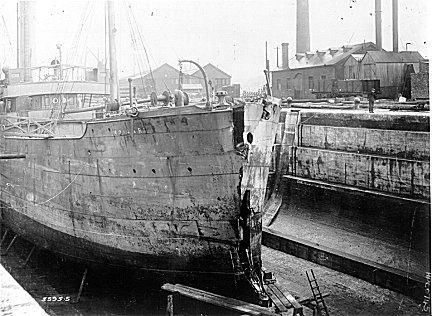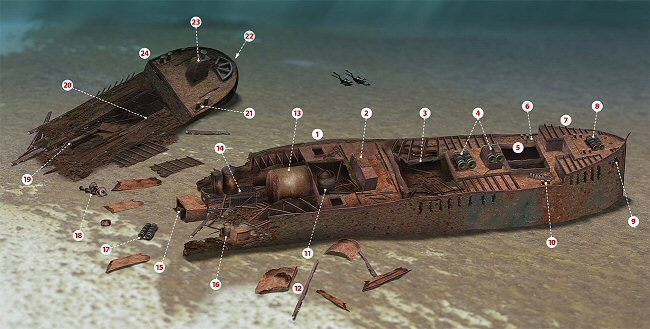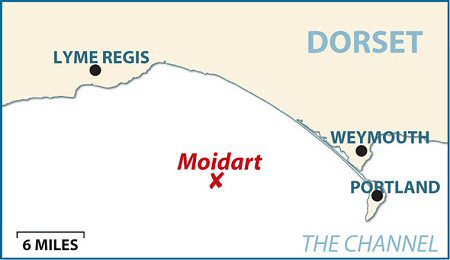This Victorian steamer was torpedoed off the Dorset coast towards the end of World War One, and makes a good club dive. JOHN LIDDIARD, with the aid of MAX ELLIS’s illustration, aims to clear up confusion about navigating the wreck

THIS MONTH’S TOUR of the steamship Moidart was not the easiest to sketch. The difficulty was in laying out where the torpedo from UC77 had blown it in two, just aft of the engine-room; and where the stern lay in comparison to the rest of the wreck and how to get to it.
There were various accounts about the stern being so many metres from the forward part, about it being alongside, about it being twisted round, and about there being a trail of wreckage between the two, but while all these descriptions must have made sense to someone, they didn’t really give me enough information to work out a Wreck Tour.
It took me a couple of dives, first with Smudge from Portland and second with Douglas Lanfear from Lyme Regis, to complete the sketch. And in the end, the answer was obvious – “all of the above”. But more of that later.
For both of my dives on the Moidart , the shot was dropped towards the aft end of the forward section, just across the port side.
Staying above the deck for now at about 30m, a small coaming to the side of the deck (1) is one of the bunker-hatches for loading coal.
A little further forward, a raised box area (2) is the base of the wheelhouse. The upper part, being built of wood, decayed long ago.
Interesting details just forward of this are pulley wheels for routeing of the steering cable mounted on the main deck.
The deck and coaming around the second hold (3) have collapsed inwards, and holes have rotted between the ribs on both sides of the hull. The hold is part-filled with silt, and there may be some coal or steel from the Moidart’s cargo beneath.
Between the forward holds are a pair of cargo-winches (4), with the foot of the mast between them and a spare anchor. The first hold (5) is more intact, with a complete coaming and beams across to support the hatch-cover.
As usual with ships of this age, the Moidart has a raised forecastle, with steps leading up from the main deck.
On the port side these steps have fallen to the deck, next to a pair of bollards and a small Admiralty-pattern anchor (6).
Above the forecastle, most of the decking has rotted away (7), making it easy to shine a light below. Access inside is trickier, however, because it’s from the main deck over banked silt.
Over the forward part of the forecastle the steel decking remains, supporting two pairs of bollards behind an anchor-winch (8). Just over the bow, the starboard anchor is held tightly in place (9), but the port anchor is missing.
The depth of the seabed is about 33m, but there is little reason to descend at this point of the dive.
Now heading aft again along the starboard side, behind the forecastle is another set of steps (10) and a pair of bollards. Back amidships, behind the wheelhouse, is an upright cylindrical water-tank (11), just in from the starboard bunker-hatch. Looking over the side, scattered debris (12) on the seabed comes from the superstructure and the wheelhouse.
Aft of the water tank is the Moidart’s single boiler (13), followed by a compound engine (14). Here the sides of the hull are broken down to the seabed.
Behind the engine, the thrust-bearing (15) remains in place, but the propeller-shaft is then broken at a coupling flange. To starboard, a pump (16) from the engine-room lies across the side of the hull.
Heading out in line with the propeller-shaft, the aft part of the Moidart is not where you would expect it to be, and the last major piece of wreckage is part of a broken cargo-winch (17).
The route to the stern lies further to port, where scraps of wreckage provide a not-quite-continuous trail almost perpendicular to the line of the wreck.
A sign that you are heading in the right direction is the other part of the broken winch (18). Then the stern appears, with the propeller-shaft jutting out (19).
The stern has twisted back not quite in line with the forward part of the wreck.
It has capsized to port, so that the port side of the deck meets the seabed at 33m and the starboard side is 5m above.
A partially intact coaming (20) indicates a single aft hold.
The stern steps up from the main deck, with a pair of bollards (21) to the port side being just above the 33m seabed.
Beneath the stern and out of view on our illustration, the rudder and propeller (22) are in place, with the rudder twisted slightly to port.
Above the stern, the steering quadrant is similarly turned to port.
A flanged box in the middle of the deck (23) is the base for a gun-mount, though the gun itself has been salvaged, and is on display at the National Maritime Museum.
Our tour of the Moidart ends with a pair of bollards to the starboard side of the stern (24), this being the shallowest part of it, and a convenient place to launch a delayed SMB.
Thanks to Smudge and Douglas Lanfear.
SUBMARINE SHOCK
THE MOIDART, armed freighter. BUILT 1878, SUNK 1918
SHE WAS BUILT AND LAUNCHED as a 1303-ton, schooner-rigged 243ft long steamer, with a beam of 32ft. Forty years later, the Moidart came to a very sudden end, writes Kendall McDonald.
They had put a gun on her stern, and given her crew two extra Royal Navy gunners to man it, but it was never fired in anger. Moidart’s last voyage was up-Channel, from Cardiff for Le Havre, a wartime supply run with a cargo of 1550 tons of Welsh coal and another 80 tons of steel plates.
At 2am on 9 June, 1918, her captain George Skea was in the chartroom plotting out where he would turn away from the English coast and head for the French port. He was 14 miles north-west of Portland Bill, and it was nearly time to start turning.
On watch on the bridge was the first mate, William Drever. The sea was calm, the moon out and visibility was good, but Drever got a sudden shock. A large submarine appeared on his starboard side, only 400m away. The look-outs apparently hadn’t seen it.
Drever ordered the helm hard over, to put the submarine directly astern. He then raced to the chartroom to alert the captain.
But in less than a minute a torpedo struck the Moidart to starboard near the stern gun, and she began to settle. Another minute, and she sank by the stern. No boats could be launched, and most of the 21 crew found themselves either in or under the water.
At the height of the struggle to find something that would float, the German submarine glided into the middle of the struggling men and, ignoring their cries for help, demanded to know the name of their ship.
Some of the crew finally found one of the boats floating upside-down, and six men clung to it for six hours until they were picked up by a passing Glasgow steamer, the Clifton Grove. They were the sole survivors.
The U-boat that sank the Moidart was UC77, commanded by Oberleutnant Johannes Ries. He and his crew were all killed just one month later on 10 July, when they were depth-charged by two Royal Navy trawlers in the Dover Straits.
Both the Moidart’s gun and bell have been raised by divers.
TOUR GUIDE
GETTING THERE: For Weymouth, follow the A37 or A354 to Dorchester, then the A354 to Weymouth and continue to Portland via Chesil Beach, turning left for the old Castletown dockyard as the road starts to climb the hill to Portland. Scimitar Diving is located at the Aqua Hotel, on the left as you enter Castletown.
For Lyme Regis, leave the M5 at junction 25 (Taunton) and take the A358 past Chard to Axminster, then the A35 and B3165 to Lyme Regis, and follow the signs to the Cobb.
HOW TO FIND IT: The GPS co-ordinates are 50.34.043N, 002.47.288W (degrees, minutes and decimals). The wreck lies with its bow just to the east of north.
TIDES: Slack water is 3.5 hours after high water Portland.
DIVING & AIR: Scimitar Diving, 07765 326728. Blue Turtle, 07970 856822.
ACCOMMODATION: Portland, 01305 860269, Hotel Aqua. Lyme Regis.
QUALIFICATIONS: Comfortable for a BSAC Sports Diver, but deep enough to require a deep speciality for those from a PADI background.
LAUNCHING: Slips are available at Weymouth, Portland and Lyme Regis. Harbour and launch fees are payable
FURTHER INFORMATION: Admiralty Chart 3315, Berry Head to Bill of Portland. Ordnance Survey Map 193, Taunton & Lyme Regis. Ordnance Survey Map 194, Dorchester, Weymouth & Surrounding Area. Dive Dorset, by John & Vicki Hinchcliffe. WW1 Channel Wrecks, by Neil Maw.
PROS: A good club dive.
CONS: Navigation to the stern used to be confusing (but we hope this Wreck Tour has cured that!).
DEPTH: -20M, 20M-35M and 45M+
Appeared in DIVER December 2010






